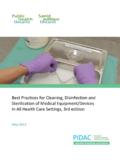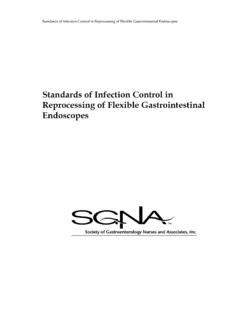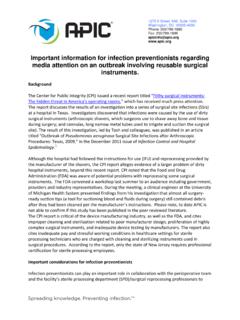Transcription of Workshop on Medical Device Cleanliness: How Clean is …
1 Workshop on Medical Device cleanliness : How Clean is Clean Enough? Sponsored by ASTM Committee F04 on Medical and Surgical Materials and devices November 16, 2010. Grand Hyatt San Antonio San Antonio, TX. Workshop Co-Chairs: Reto Luginbuehl Robert Mathys Foundation Bettlach, Switzerland Stephen Spiegelberg Cambridge Polymer Group Boston, MA. Terry Woods FDA. Silver Spring, MD. TUESDAY, NOVEMBER 16, 2010. Program: page 2. Abstracts: page 4. Presentations: page 25. All presentations provided within this pdf-file were obtained by written consent of the authors. The copyright remains with the authors and permissions shall be obtained before using the information any respect. Workshop on Medical Device cleanliness : How Clean is Clean Enough? Sponsored by ASTM Committee F04 on Medical and Surgical Materials and devices Program TUESDAY, NOVEMBER 16, 2010. Opening Remarks Reto Luginbuehl, Robert Mathys Foundation, Bettlach, Switzerland Stephen Spiegelberg, Cambridge Polymer Group, Boston, MA.
2 Terry Woods, FDA, Silver Spring, MD. SESSION 1: FDA AND LEGAL IMPLICATIONS. Reprocessing of Reusable Medical devices : an FDA Perspective Pamela Scott, Daniel McGunagle, FDA, Silver Spring, MD. The Legal Implications of Medical Device cleanliness Standards Steve Bennett, John Schlafer, Baker & Daniels, LLP, Fort Wayne, IN. SESSION 2: CLEANING AND TESTING, PART 1. Exploring Methods of Optimizing Surgical Instrument Reprocessing Operations Jahan Azizi, Linda Lavey, CBET, University of Michigan, Dearborn, MI, USA. Validation Strategy for an Automated Endoscope Reprocessor Bradley Catalone, Thomas Gilmore, David Barlow, Olympus America, Center Valley, PA, USA. Effects of Non-Aqueous Vapor Degreasing Solvent Cleaning on Ultra-High Molecular Weight Polyethylene (UHMWPE). Ray Gsell, Zimmer, Warsaw, IN, USA. Breaking the Myth that Caustic Surgical Instrument Cleaners are Necessary for Safe and Effective Decontamination of Medical devices Marcia Frieze, Case Medical , South Hackensack, NJ, USA.
3 Page 2. Workshop on Medical Device cleanliness : How Clean is Clean Enough? Sponsored by ASTM Committee F04 on Medical and Surgical Materials and devices SESSION 3: CLEANING AND TESTING, PART 2. Cleaning and Testing for Debris in Reusable Medical devices Shani Haugen, Vicki Hitchins, FDA, Silver Springs, MD, USA. Evaluation of the Cleaning Efficiency of a Aqueous Based Detergent System for Cleaning Metallic Medical devices B. Dhanapal1, N. Weiler1 and J. Rufner2, 1 Zimmer GmbH, Switzerland, 2 Zimmer Inc, Warsaw, IN, USA. Two-phase Flow Cleaning of Endoscope Channels Mohamed E. Labib1, Stanislav Dukhin1, Joseph Murawski1, Yacoob Tabani1, Richard Lai1 and Michelle Alfa2, 1. Novaflux Technologies, Princeton, NJ, USA, 2St. Boniface General Hospital, Winnipeg, Canada Assessment of Organic Residues on Medical devices B. Dhanapal1, D. Zurbr gg,2, J. Rufner3, R. Gsell4, 1 Zimmer GmbH, Switzerland, 2 Niutec AG, Switzerland, 3. Zimmer Inc, Warsaw, IN, USA, SESSION 4: ESTABLISHING CLEANING LIMITS.
4 Establishing and Justifying Limit Values for Residual Analysis Kierstan Andrascik, QVET Consulting, Layton, UT, USA. Residual Soil on Reusable Medical devices : How to Determine Limits? Steve Goldstein, Steve Goldstein Consultants, Albuquerque, NM, USA. page 3. Workshop on Medical Device cleanliness : How Clean is Clean Enough? Sponsored by ASTM Committee F04 on Medical and Surgical Materials and devices SESSION 1: FDA AND LEGAL IMPLICATIONS. Reprocessing of Reusable Medical devices : an FDA Perspective Pamela Scott, Daniel McGunagle, FDA, Silver Spring, MD. Ineffective reprocessing of reusable Medical devices continues to present a public health risk and reports to FDA. from numerous facilities highlight problems with contamination and debris retention. The FDA believes that the incidents can be prevented through approaches including (but not limited to): (1) improved labeling and cleaning practices, (2) rigorous validation of the reprocessing instructions, (3) design features that facilitate cleaning and (4) user facilities implementing strong quality assurance programs.
5 The recently published Safety Communication from FDA, CDC and the VA: Preventing Cross-Contamination in Endoscope Processing is one example of specific actions to reduce risk. At this Workshop , FDA staff will discuss best practices for the reprocessing of all reusable Medical devices . The FDA actively works with manufacturers, facilities and health care professionals to improve the reusable Medical Device landscape and to strengthen standardized practices for reprocessing. Drawing on clinical standards and FDA guidance, FDA staff will touch on key program areas where there are opportunities to improve the effectiveness of reprocessing of reusable Medical devices . QR SUHVHQWDWLRQ DYDLODEOH. page 4. Workshop on Medical Device cleanliness : How Clean is Clean Enough? Sponsored by ASTM Committee F04 on Medical and Surgical Materials and devices The Legal Implications of Medical Device cleanliness Standards Steve Bennett, John Schlafer, Baker & Daniels, LLP, Fort Wayne, IN.
6 The question "How Clean is Clean enough?" has been approached and answered in different ways in the legal world. Some focus on a manufacturer's validated cleaning process; others on one specific result, the absence of residue. The discussion and debate over cleanliness standards and contamination have been and will continue to be played out against the backdrop of product liability litigation, product recalls, and patient safety concerns. Therefore, the development of cleanliness standards by the ASTM will have legal implications for stakeholders in the Medical Device field. An industry standard for cleanliness that defines acceptable residue limits, as well as appropriate testing methods for certain residues, will impact the defect analysis in product liability litigation. An ASTM cleanliness standard could become the guidepost for determining whether a specific explanted Medical Device contains a manufacturing defect, , a deviation from the intended design specification.
7 Accordingly, consideration should be given to the utility of such a standard in the context of explant analysis for contaminants. A cleanliness standard also could be used as a legal framework for determining the adequacy of a manufacturer's cleaning and quality assurance processes. Inconsistencies between a manufacturer's cleaning process and an ASTM cleanliness standard might expose a manufacturer to the claim that a Medical Device is defective. On the other hand, an ASTM standard could be used by a manufacturer to defend its validated cleaning process as "state of the art" or in conformance with industry standards. Consideration also should be given to the interplay between an ASTM cleanliness standard and the requirements of regulatory bodies. For example, the FDA's Good Manufacturing Practices regulations require manufacturers to have procedures "for the use and removal of such manufacturing material to ensure that it is removed or limited to an amount that does not adversely affect the Device 's quality.
8 " 21 (h). The regulations do not define specific residues, residue limit values, or methods for testing. A Medical Device industry standard that provides those definitions may have an impact on cleanliness regulations or the legal interpretation of the regulations. This presentation will touch on all of the above legal ramifications of defining or not defining acceptable residue limits. Case examples will be presented, and litigation, regulatory, and risk management considerations will be addressed. no presentation available page 5. Workshop on Medical Device cleanliness : How Clean is Clean Enough? Sponsored by ASTM Committee F04 on Medical and Surgical Materials and devices SESSION 2: CLEANING AND TESTING, PART 1. Exploring Methods of Optimizing Surgical Instrument Reprocessing Operations Jahan Azizi, Linda Lavey, CBET, University of Michigan, Dearborn, MI. The elimination of bioburden from reusable surgical instruments represents an ongoing challenge for the manufacturers of such instruments, the hospitals using them, and the patients relying on them for their health and safety.
9 Recognizing this challenge, a team of risk management personnel and instrument room technicians at the University of Michigan Hospitals and Health Centers have undertaken a project focusing on directed testing of the manufacturer's recommended cleaning methods for surgical instruments. The objective of this testing is to determine the efficacy of automated instrument reprocessing methods with the goal of finding the optimum means of sterilizing valuable surgical tools. Faced with an array of instruments available for testing, investigators settled on suction tips, useful due to their application in virtually every kind of surgery, their exposure to high levels of bioburden, and their known difficulty to Clean . This study focuses on a variety of suction tips used in orthopedic, neurosurgery, and otolaryngology surgical procedures. Methods involve a dedicated workstation designed for this project and set up with a Midbrooks reprocessing machine; a digital video outfit for taking intra-lumen snapshots using flexible scope cameras ranging in size from mm to mm; and supplies for determining the presence of protein, ATP (adenosine triphosphate), carbohydrate, and hemoglobin as markers for bioburden still present.
10 In addition, enzyme solution and hand tools for manual cleaning were available for continued testing as needed. Testing so far has included three phases: Phase 1: Visual check: Suction tips are tested for protein before and after cleaning. Still photographs are taken throughout, showing bioburden present. Phase 2: ATP Check: A sample of suction tips is tested for ATP and hemoglobin. Phase 3: Comparison Testing Using ATP and Channel Check (testing for protein, hemoglobin, and carbohydrate): Instruments undergo cleaning using the manufacturer's recommended processes, requiring as many as three wash cycles. All are tested using ATP and hemoglobin test kits after each cycle. page 6. Workshop on Medical Device cleanliness : How Clean is Clean Enough? Sponsored by ASTM Committee F04 on Medical and Surgical Materials and devices Initial testing found bioburden remaining on 100% of the instruments. Additional cleanings were required to reach a predetermined cleanliness goal.








